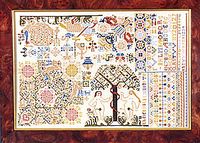

The verse for this sampler reads: "Absent or Dead Still let A friend be dear A Sigh the absent claim, The Dead a Tear." I made the sampler during a time of mourning for the loss of a family very dear to me who were killed in an airplane crash. Making the sampler helped with the greiving but I am not sure why. I do have some ideas though.
First, I chose this verse from a book of sampler verses by Bolton & Coe. These two ladies went through thousands of samplers and wrote down the verses and where they first appeared. It is one of the best books on samplers that I have seen. You can't really understand the function of samplers in the rearing of young girls unless you read a wide variety of sampler verses. One of the most common threads is the brevity of life. Most of the sampler workers saw death as a constant companion. They were instructed by their mothers or teachers to adapt heavenly values because life could end quickly and it so often did. The sampler verses were designed to instill virtures, or at least make the young needleworker aware of them.
So, why did working on this sampler help me with my grief? The family was what you might call a perfect family. They were living as admirable a life as I think anyone would aspire to. They were good citizens and church leaders. The girls were popular and good students. They had so many friends who loved them dearly and yet, suddenly, they were gone. They were the kind of people that nothing bad should have happened to and the very worst happened. I had to put that into perspective and picking out the verse helped. I read so many verses and saw what a frequent companion death was to our ancestors. The verse seems to accept that friends we hold dear might die. They could also move away and the chances were that they would never be seen again on this earth.
Those early settlers from the Old Country knew that they would probably never see their friends or relatives again and yet they left to make a new life for themselves and their children. This began to put death into perspective for me. We move a great deal these days, but we are only an airplane ride away from anyone we want to see. We can call them on the phone easily and now, with cell phones, we don't even have to know where they are. We can still reach them. guess I thought that people whom I loved should always be available to me. It doesn't always work that way.
As I stitched that sampler, I thought about all these things. In a strange way, I felt a kinship with those young girls whose lives were so touched by sorrow. This world is just a temporary place for us. Ever since this sorrow, I've held my friends and family more dearly. I know they can be gone in an instant. In the stitches of this sampler were thousands of memories of my friends that I will always treasure, and a lesson taught to little girls three centuries ago.




